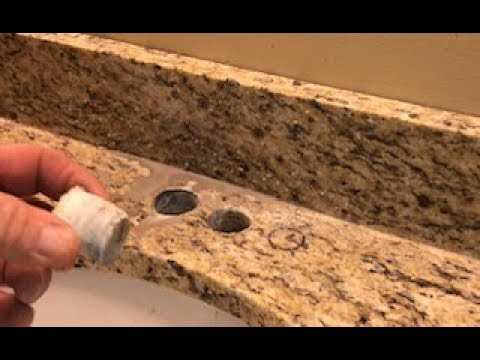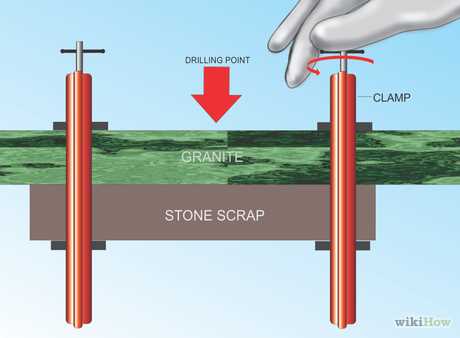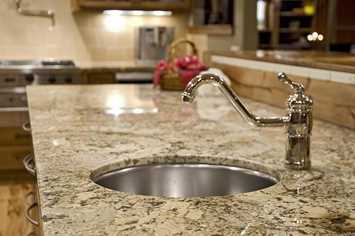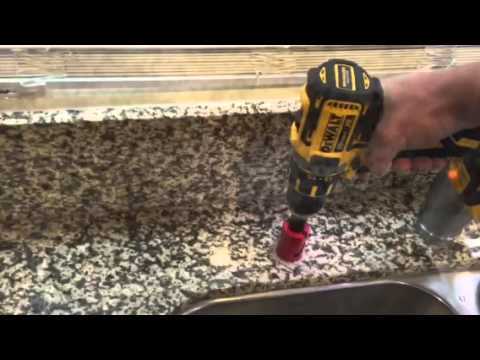Tips for Drilling through a Granite Countertop

Granite countertops are a popular choice for kitchens and bathrooms due to their durability and natural beauty. However, drilling through a granite countertop can be a challenging task if you don’t have the right tools and techniques. Whether you are installing a new faucet or adding an appliance to your countertop, here are some tips to help you successfully drill through granite.
1. Use a diamond-tipped drill bit: Granite is an extremely hard material, so regular drill bits may not be strong enough to penetrate the surface. Diamond-tipped drill bits are specifically designed to cut through granite and other hard stones. Make sure to choose a drill bit that matches the size of the hole you want to drill.
2. Mark the drilling spot: Before you start drilling, mark the exact spot where you want to make the hole. Use a pencil or a piece of tape to make a clear mark. This will help you to drill the hole accurately and prevent it from moving or shifting while drilling.
3. Use water as a lubricant: Drilling through granite produces a lot of heat and friction, which can damage your drill bit. To prevent this, it is important to keep the drill bit cool. Pour a small amount of water onto the drilling spot to act as a lubricant. This will help to dissipate the heat and extend the life of your drill bit.
Pro tip: You can also use a spray bottle filled with water to continuously spray the drilling spot while drilling. This will keep the area cool and prevent the drill bit from overheating.
4. Start with a small pilot hole: To avoid cracking or chipping the granite, it is recommended to start drilling with a small pilot hole. Use a low drilling speed and apply gentle pressure. Once the pilot hole is made, you can gradually increase the drilling speed and widen the hole using a larger drill bit.
5. Take breaks: Drilling through granite requires patience and precision. It is important to take breaks during the drilling process to prevent overheating of the drill bit and to avoid putting too much pressure on the granite. Give the drill bit a chance to cool down before continuing.
By following these tips, you can successfully drill through a granite countertop without damaging the surface. Remember to always wear safety goggles and gloves when using power tools, and take your time to ensure accurate drilling. If you are unsure about drilling through granite, it is recommended to consult with a professional.
Selecting the Right Drill Bit for Granite
When drilling through a granite countertop, it is important to use the correct drill bit to ensure clean and accurate holes. Here are some tips for selecting the right drill bit for granite:
- Diamond Core Bits: Diamond core bits are commonly used for drilling through granite. These drill bits are made with a diamond-impregnated tip, which makes them extremely durable and efficient for cutting through hard materials like granite.
- Carbide Tipped Bits: Carbide tipped drill bits are another option for drilling through granite. These bits have a tungsten carbide tip, which provides excellent strength and durability. However, they may not be as efficient as diamond core bits.
- Size: When choosing a drill bit for granite, consider the size of the hole you need to drill. Drill bits are available in a variety of sizes, so be sure to select one that matches your specific requirements.
- Wet or Dry Drilling: Depending on your drilling application, you may need to choose between wet or dry drilling. Wet drilling is typically recommended for drilling through granite, as it helps to cool the drill bit and reduce dust. However, if wet drilling is not suitable for your situation, there are dry drilling options available as well.
It is important to note that drilling through granite can be challenging and require special equipment and techniques. If you are unsure or inexperienced, it is best to seek professional assistance to avoid damaging the countertop or causing injury.
Preparing the Granite Countertop for Drilling
1. Measure and Mark the Area

Before starting the drilling process, it is crucial to measure and mark the exact area where you want to drill the hole. Use a measuring tape and a pencil to mark the location accurately.
2. Choose the Right Drill Bit
Granite is a hard material, so it is essential to choose the right drill bit for the job. A diamond-tipped drill bit or a carbide-tipped masonry drill bit is recommended for drilling through granite. Make sure the drill bit is suitable for the size of the hole you want to create.
3. Use Water as a Lubricant
During the drilling process, using water as a lubricant is essential to keep the drill bit cool and prevent it from overheating. Pour water onto the area where you plan to drill the hole to lubricate the surface.
4. Secure the Countertop
Before drilling, make sure the countertop is secure and won’t move during the drilling process. You can use clamps or a non-slip mat to hold the countertop in place and prevent any accidental movements.
5. Create a Pilot Hole
Creating a pilot hole helps guide the drill bit and prevents it from slipping off the marked area. Start by drilling a small hole with a smaller drill bit before proceeding to the larger bit needed for the final hole size.
6. Start Drilling

Once the pilot hole is created, you can start drilling the final hole. Apply gentle and steady pressure while drilling into the granite. Avoid using excessive force, as this can damage the countertop or the drill bit.
7. Clean the Area
After drilling the hole, make sure to clean the area around it to remove any debris or dust. You can use a soft cloth or a vacuum cleaner to clean the surface thoroughly.
8. Take Breaks

Drilling through granite can be a time-consuming process, so it is important to take breaks to let the drill bit and granite cool down. This will prevent overheating and prolong the life of the drill bit.
9. Wear Safety Gear
Always wear appropriate safety gear, such as safety glasses, gloves, and a dust mask, to protect yourself during the drilling process. Granite particles and dust can be harmful if inhaled or exposed to the skin.
10. Practice Proper Technique
To ensure a successful drilling process, it is crucial to use proper technique. Use a slow and steady drilling speed, maintain a perpendicular angle to the countertop, and let the drill do the work. Applying too much force or drilling at a wrong angle can lead to damage or breakage.
By following these steps and taking necessary precautions, you can prepare your granite countertop for drilling and achieve the desired results without causing any damage.
Marking the Drilling Location on the Granite Countertop
Before you start drilling through your granite countertop, it is crucial to accurately mark the drilling location. This will help ensure that the holes are positioned correctly and prevent any damage to the countertop.
Here are some steps to follow when marking the drilling location on the granite countertop:
- Measure and mark the desired hole locations: Use a measuring tape or ruler to determine the exact position of the holes you need to drill. Take into consideration the size and shape of the items that will be installed, such as faucets or sinks, and mark these locations on the surface of the countertop using a pencil or a marker.
- Create guide marks: To further ensure accuracy, it is advisable to create guide marks on the surface of the countertop. This can be done by placing a small piece of masking tape over the marked drilling location. The tape will act as a visual guide and prevent the drill bit from slipping during the drilling process.
- Double-check the measurements: Before proceeding with drilling, double-check the measurements and ensure that the marked locations align with the desired placement of the items. This step is crucial to avoid any mistakes and potential damage to the countertop.
By following these steps, you can effectively mark the drilling location on your granite countertop and proceed with confidence to the drilling process.
Using Proper Techniques for Drilling through Granite
Choose the Right Drill Bit
When drilling through granite, it is essential to use the correct type of drill bit. Diamond-tipped drill bits are the most effective option for drilling through granite. These bits are designed to handle the hard surface of the stone and provide clean and precise holes.
Mark the Hole
Before starting to drill, it is important to mark the exact spot where you want the hole to be. Use a pencil or a marker to make a visible mark on the surface of the granite. This will help guide your drill bit and ensure that you drill in the right place.
Use Water as Lubrication
Drilling through granite can generate a lot of heat, which can be harmful to both the drill bit and the granite. To prevent overheating, it is crucial to use water as a lubricant while drilling. You can either have a steady stream of water running over the drill bit or pour water directly into the hole as you drill.
Start Slowly
When you begin drilling, it is important to start at a slow speed. This allows the drill bit to penetrate the granite gradually without putting excessive pressure on it. Once the hole is established, you can increase the drilling speed to make the process more efficient.
Apply Constant Pressure

While drilling through granite, it is important to apply constant and steady pressure to the drill. This will help ensure a clean and precise hole. Avoid pushing too hard, as this can cause the drill bit to break or damage the surrounding granite.
Clean the Drill Bit Regularly
As you drill through the granite, it is common for stone particles to accumulate on the drill bit. These particles can hinder the drilling process and reduce the effectiveness of the drill bit. Make sure to clean the drill bit regularly by removing any debris or dust that may have gathered on it.
Use Clamps or Braces
To prevent the granite countertop from shifting or moving while drilling, it is recommended to use clamps or braces to secure it in place. This will provide stability and ensure that the holes are drilled accurately.
Work in Small Sections
When drilling through a granite countertop, it is best to work in small sections. This allows you to maintain control and accuracy throughout the drilling process. Take breaks as needed to clean the drill bit and remove any debris.
Be Patient
Drilling through granite can be a time-consuming task, so it is important to be patient. Rushing the process can lead to mistakes or damage to the granite. Take your time and follow the proper techniques for the best results.
| Tools | Materials |
|---|---|
|
|
Maintaining Coolant and Lubrication during the Drilling Process
Drilling through a granite countertop can generate a significant amount of heat due to the hard and dense nature of the material. To prevent overheating and ensure proper drilling, it is essential to maintain coolant and lubrication throughout the drilling process.
Coolant Options
There are several coolant options that can be used to keep the drill bit and the granite countertop cool. These include:
- Water: Water is a commonly used coolant for drilling granite. It is readily available, affordable, and effective in dissipating heat. To use water as a coolant, continually pour it onto the drilling area during the process.
- Cutting Oil: Cutting oil is another option for cooling and lubricating the drill bit. It reduces friction and heat buildup, prolonging the life of the drill bit. Apply cutting oil to the drilling area before and during the drilling process.
- Coolant Sprays: Coolant sprays are specifically designed for cooling and lubricating during drilling operations. These sprays come in aerosol cans and can be sprayed onto the drilling area as needed.
Proper Application
To ensure effective cooling and lubrication, it is important to apply the coolant correctly. Follow these steps:
- Begin by marking the drilling spot on the granite countertop.
- Drill a small pilot hole using a diamond-tipped drill bit, starting at a slow speed.
- Once the pilot hole is established, increase the drill speed and apply the coolant to the drilling area.
- Continue drilling, periodically pausing to reapply the coolant to prevent overheating.
- After completing the drilling process, clean any residual coolant from the countertop using a soft cloth.
Protective Measures
In addition to using coolant and lubrication, there are additional measures you can take to protect the drill bit and ensure a successful drilling process:
- Use a Guide: Using a guide or template can help maintain drilling accuracy and prevent the drill bit from slipping or wandering.
- Apply Light Pressure: Applying excessive pressure during drilling can cause the drill bit to overheat and potentially damage the countertop. Apply gentle, steady pressure to avoid this.
- Take Breaks: If the drilling process is lengthy, take short breaks to allow the drill bit and countertop to cool down.
By maintaining coolant and lubrication, applying the proper technique, and taking protective measures, you can successfully drill through a granite countertop without damaging the material or the drill bit.
Removing the Dust and Debris while Drilling through Granite

When drilling through a granite countertop, it is important to take precautions to remove the dust and debris that is created during the drilling process. Without proper cleaning, the dust and debris can cause damage to your countertop and create a messy work environment. Here are some tips for removing the dust and debris while drilling through granite:
- Wear Personal Protective Equipment (PPE): Before you begin drilling, make sure to wear appropriate personal protective equipment such as safety goggles, a dust mask, and gloves. This will help protect you from inhaling the dust and prevent any debris from getting in your eyes or on your skin.
- Use a Wet Diamond Core Bit: Using a wet diamond core bit can help minimize the amount of dust that is created during the drilling process. The water helps to lubricate the bit and keeps it cool, while also effectively capturing and suppressing the dust. Make sure to attach a water source to the drill to continuously supply water to the drilling area.
- Place a Drop Cloth or Plastic Sheet: To catch the dust and debris as it falls, place a drop cloth or plastic sheet under the area where you will be drilling. This will make for easier cleanup once you have finished drilling.
- Use a Vacuum or Dust Extractor: While drilling, it is a good idea to have a vacuum or dust extractor nearby to help remove the dust as it is created. Attach the vacuum to the drill or use a separate handheld vacuum to suck up the dust and debris. This will help prevent it from spreading throughout your work area.
- Clean up the Area Afterwards: Once you have finished drilling, it is important to thoroughly clean up the area. Use a damp cloth or sponge to wipe down the countertop and remove any remaining dust and debris. Dispose of the drop cloth or plastic sheet and empty the vacuum or dust extractor.
By following these tips, you can effectively remove the dust and debris while drilling through a granite countertop. This will help protect your countertop from damage and create a clean and safe work environment.
Finishing and Cleaning the Drilled Hole in the Granite Countertop
Once you have successfully drilled a hole in your granite countertop, it is important to properly finish and clean the drilled hole to ensure a professional and polished look. Here are some tips to help you achieve the desired results:
1. Sand and Smooth the Edges
Use a sanding block or sandpaper with a high grit (around 400 or higher) to sand and smooth the edges of the drilled hole. This will help remove any rough or uneven surfaces and create a clean edge.
2. Clean the Hole
After sanding, clean the drilled hole thoroughly to remove any dust or debris. You can use a small brush or compressed air to ensure that the hole is clean and ready for further treatment.
3. Apply a Stone Sealer
To protect the granite and enhance its appearance, consider applying a stone sealer to the drilled hole. Follow the manufacturer’s instructions for application and allow the sealer to dry completely before moving on to the next step.
4. Apply a Stone Polish
To achieve a glossy finish, you can apply a stone polish to the drilled hole. Apply a small amount of the polish onto a soft cloth and gently rub it onto the surface of the hole. Buff the area to a shine using circular motions.
5. Clean and Polish the Surrounding Area
Once the drilled hole is finished and polished, clean and polish the surrounding area of the granite countertop to ensure a seamless look. Use a granite cleaner and a soft cloth to clean the surface and remove any fingerprints or smudges.
6. Inspect and Touch Up if Needed
Inspect the finished hole and surrounding area for any imperfections or areas that may need touch up. If necessary, repeat the previous steps to achieve the desired result.
Following these steps will help ensure that the drilled hole in your granite countertop looks professional and blends in seamlessly with the rest of the surface. Remember to take your time and work carefully to achieve the best results.
FAQ:
What is the best type of drill bit to use for drilling through a granite countertop?
The best type of drill bit to use for drilling through a granite countertop is a diamond-tipped drill bit. Diamond is the hardest known substance, so it is able to easily drill through the tough surface of granite.
Do I need to use water while drilling through a granite countertop?
Yes, it is recommended to use water while drilling through a granite countertop. The water helps to cool down the drill bit, preventing it from overheating. It also helps in reducing the amount of dust created during the drilling process.
Can I use a regular drill to drill through a granite countertop?
No, a regular drill is not suitable for drilling through a granite countertop. You will need to use a drill that has a high torque and is specifically designed for drilling through hard materials like granite. Using a regular drill can damage both the drill and the countertop.
Is it necessary to mark the drilling spot before drilling into a granite countertop?
Yes, it is highly recommended to mark the drilling spot before drilling into a granite countertop. This will help ensure that you drill at the correct location and prevent any mistakes. You can use a pencil or masking tape to mark the spot.
How do I prevent the drill bit from slipping on the granite countertop?
To prevent the drill bit from slipping on the granite countertop, it is important to create a small pilot hole first. This can be done using a smaller drill bit. Once the pilot hole is created, you can then switch to the diamond-tipped drill bit and continue drilling.
What should I do if the drill bit gets stuck while drilling through a granite countertop?
If the drill bit gets stuck while drilling through a granite countertop, you should stop drilling immediately. Trying to force the drill bit will only cause more damage. You can try using a lubricant, such as water or oil, to loosen the bit. If that doesn’t work, it is best to seek professional help to remove the stuck drill bit.
Video:







